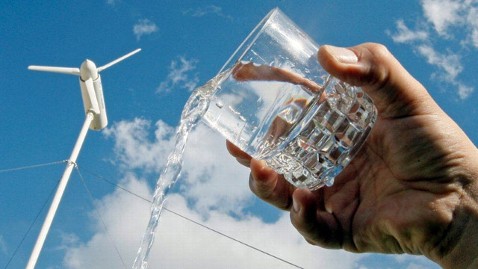Changing Cities: A Wind Turbine That Creates Fresh Water Out of Thin Air

(Eole Water)
For the nearly 20 percent of the world's population who live in areas without access to fresh drinking water, getting access is a matter of life or death. Inspired by the mechanics of a dripping air conditioner, French inventor Marc Parent was inspired to create a solution that could bring fresh water to the most remote, driest parts of the world.
Parent created a company, Eole Water, that produces wind turbines that literally pull fresh water out of thin air. His solution, dubbed the WMS1000 uses the electricity generated from a windmill to collect and treat water without tapping into a water source such as a river, lake or well.
Eole Water is testing the invention in France and Abu Dhabi. The invention, if the company can get the economics to work, looks to be a promising solution to the water crisis.
I recently interviewed Thibault Janin, Marketing and Communication Director of Eole Water on the WMS 1000 turbine to find out what's in store for this new technology.
How was the idea of a wind turbine that produces water developed? Thibault Janin: The idea came from Marc Parent, founder of Eole Water, when he lived in the Caribbean, and was subjected to water shortages. He began to work on a system that could recover moisture from the air and transform it into water. Soon after, he returned to France. He patented the process and founded Eole Water.
Millions of people worldwide live in remote areas without any access to safe drinking water. What is the potential for the Eole system to solve this issue? Thibault Janin: Each unit can create 1,000 liters of drinking water using only moisture and powered only by wind. Let me highlight this word : CREATE. All existing solutions (wells, desalination, lakes/rivers pumping, etc.) only treat an existing source of water. Thus, what happens when there is no or no more water available? The WMS1000 can create water when there is no existing source available. That makes a difference. Our technology integrates water creation, water collection, water treatment and water local distribution. The WMS1000 can produce and distribute water everywhere.
Today, people only use centralized distribution, from a center point to others. With our turbine, we wish to decentralize the water access. As the logistics and the process are easy to install and operate, it will be an answer to various issues like massive population movements that cause swelling of cities, increased diseases and therefore health care costs increasing, (it can also be) a door to agriculture or a local industry beginning. All economic or welfare starts with access to water. And this is what we provide.
Are any of these turbines in place and operational? Thibault Janin: Wind turbines (first, second, third generation) can be seen at Eole Water Headquarters in Manosque in the South of France. The fourth one is used to make demonstrations during shows and exhibitions. The fifth one, the WMS1000, is the real showcase of our actual company knowledge. It has been designed and manufactured between January 2010 and December 2011. Then first tested in France between January 2011 to August 2011, and second in Abu Dhabi (Mussafah) from November 2011 to April 2012. The final location of this turbine will be Dubai by the end of 2012. The location will be opened to public.
What's the cost of production and operation of the turbine? Thibault Janin: The WMS1000 has a price of $600,000. It has been designed to operate in very remote areas, which implies that the maintenance overheads are strictly reduced to minimum. The WMS1000 wind turbine has lifetime of 20 years minimum.
What is the potential for the turbine? Thibault Janin: Thibault Janin: Do not look only at the 150 million potential customers for this technology. It is much more complex. Water is becoming increasingly scarce. Household needs in the matter should increase by 130 percent by 2030. At the same time, the WMS1000 is only one step in our development. Our range will expand to provide more precise and larger answers to communities with larger turbines featuring higher capacities of water production. We respond to a growing and constant global demand, not subjected to economic classical cycles, since water is essential to life.
What hurdles do you see standing in the way of bringing more of these wind turbines online? The major challenge for Eole Water is to make this technology more competitive in terms of price per water cubic meter. Our technology must reach maturity as quickly as possible, at several levels: production, R&D, legal or business experience.
This interview has been edited